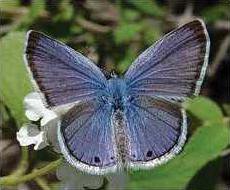The Kansas Wetlands Education Center hosted a count for the North American Butterfly Association Saturday morning. While the overall number of individuals was way down, participants found a total of 26 species of butterflies in the count radius, the highest since starting, said Pam Martin, Kansas Department of Wildlife, Parks and Tourism educator at KWEC. Only 15 different species were found in the same area in 2012.
“We rightfully didn’t expect to find that many as in years past, Martin said. Where three years ago, they spotted several hundred Swallowtails, only 36 could be found last weekend. “They’ll continue to be down until we get meaningful moisture.”
In areas that were wet, biologists found the largest concentrations. Butterflies “puddle” in muddy areas, getting nutrients from the soil that they need.
A couple of new species found for our count included the western pygmy-blue, Reakirt’s Blue and Juniper Hairstreak,” she said. These are all small butterflies. The pygmy-blue has a 1/2” wingspan. “We also found one American Snout butterfly, which is not very common here,” she said.
Observation and counting can be tricky. While spotting an isolated handful of butterflies, or even a single member of a species is easy. But for a large group, (fun fact: A group of butterflies is known as a flight, a kaleidoscope, a rabble or a swarm.), other techniques need to be employed. If the butterflies are found on specific plants or areas, observers can count an area of 10 feet by 10 feet inside the observed area and multiply. If they are in flight, observers use clickers to keep count of how many they view crossing a line 50 ft. long over a ten minute period of time, and note the size of the area in their field notes. Extrapolations are only based on the number of butterflies actually seen, according to the NABA website.
The purpose of the NABA yearly count encompassing the United States, Canada and Mexico is to track species trends. They’ve been counting for the past 40 years, but the Cheyenne Bottoms has only been included for the past four years. Already, Martin said biologists are seeing differences, in part because of the over two-years drought that has plagued the area since 2011.
However, it will be 10 years before the local data will be meaningful. That’s when they’ll be able to determine what is “normal” for the area. However, if there is growth or decline in any particular species for five or more years, it could signal significant environmental changes.
One popular species, the Monarch butterfly, is one where biologists are seeing steep declines. Habitat loss is a likely culprit. According to Martin, the area of that country where the Monarchs roost during the winter months is a canopied forest that is under pressure for lumber harvesting. The Mexican government has set aside a preserve for the butterflies, but they do not always return to the same spot each year.
“The forest canopy has to be just the right density to give the protection (Monarchs) need,” she said. “Normally, they’re numbers are so great, they can withstand this. But, we don’t know what the critical point is.”
2010 was the last really good year for spotting Monarchs at Cheyenne Bottoms. Then, thousands were spotted, but this weekend, counters only saw four in the entire count area, Martin said.
Living Kaleidoscope
Counting butterflies at the Bottoms





